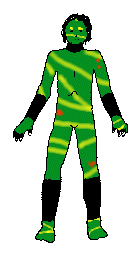
Ornament as armour
Early humans probably lived in defended camps. Caves whose entrances could be blocked with stones. Where there were no caves, the camp would have to be surrounded by a impenetrable stockade of tree branches. Within this stockade, women and children would be relatively safe.
But foraging parties would have to venture out regularly to gather food. And the predators would be waiting for them.
Weapons were probably of little use. Attack, when it came, was very sudden and powerful. A human would be immediately knocked down, and powerful jaws would grip throat or arm. Death, in many cases, would be near instantaneous. The dead or dying man would be dragged away. Even if a man possessed a spear or a dagger, it would very likely be knocked from his grasp by the impact of the initial assault. A man would only have a chance to fight if he saw the predator coming.
Without effective weapons, apart from a few clubs and stones, the foragers could only have used camouflage and body armour. But what body armour was available in the days before copper and bronze and iron?
Heavy armour would have reduced the distance a man could
travel in search of food, and also reduce the amount of food
he could carry. So the armour had to be light.

A predator attack would generally not be launched on the torso of a man, but on limbs which a predator such as a wolf or tiger could take hold. The kill would have been made by breaking the man's neck, or ripping out his throat. Thus only limited parts of men needed protection. The place that needed most protection was the neck. Hands and forearms were most in danger when a man fought a predator. Legs and ankles were endangered while running from a predator.
One simple solution was to use stone bead necklaces to protect the neck. The stones would have to have been quite large, so that no predator's teeth could penetrate to the neck. Smaller stone bead armlets and anklets would have given similar protection to arms and legs. Rings would protect fingers. Sandals could protect feet. Belts could protect the abdomen.

This light armour would not save a man from a determined predator, but it would have made it harder for any predator to kill a man quickly. A man attacked by a predator would be able to survive the initial attack, and call for help from the others in the foraging party. En masse, these might then have been able to drive off the predator, with clubs and stones. The bead armour would also reduce the damage caused by a predator. Recovery would have been quicker.
This form of light armour would not restrict movement. And because light, it would not be a burden to carry. If drilling holes in stones was beyond the capacity of early men, then more easily worked bone or hardwood could be substituted. Even seashells would serve. Human hair could have been used as the twine binding stone or wood into necklaces.

 Necklaces, armlets, anklets, and rings were not originally
purely ornamental or decorative. They were body armour.
When metals appeared, they replaced bead necklets and armlets,
because they were lighter and stronger. When spears and arrows
appeared, predators could be driven off, even killed.
Necklaces, armlets, anklets, and rings were not originally
purely ornamental or decorative. They were body armour.
When metals appeared, they replaced bead necklets and armlets,
because they were lighter and stronger. When spears and arrows
appeared, predators could be driven off, even killed.
After this time, the real need to wear this kind of armour vanished. Amulets became talismen which "warded off evil." They became purely decorative.
